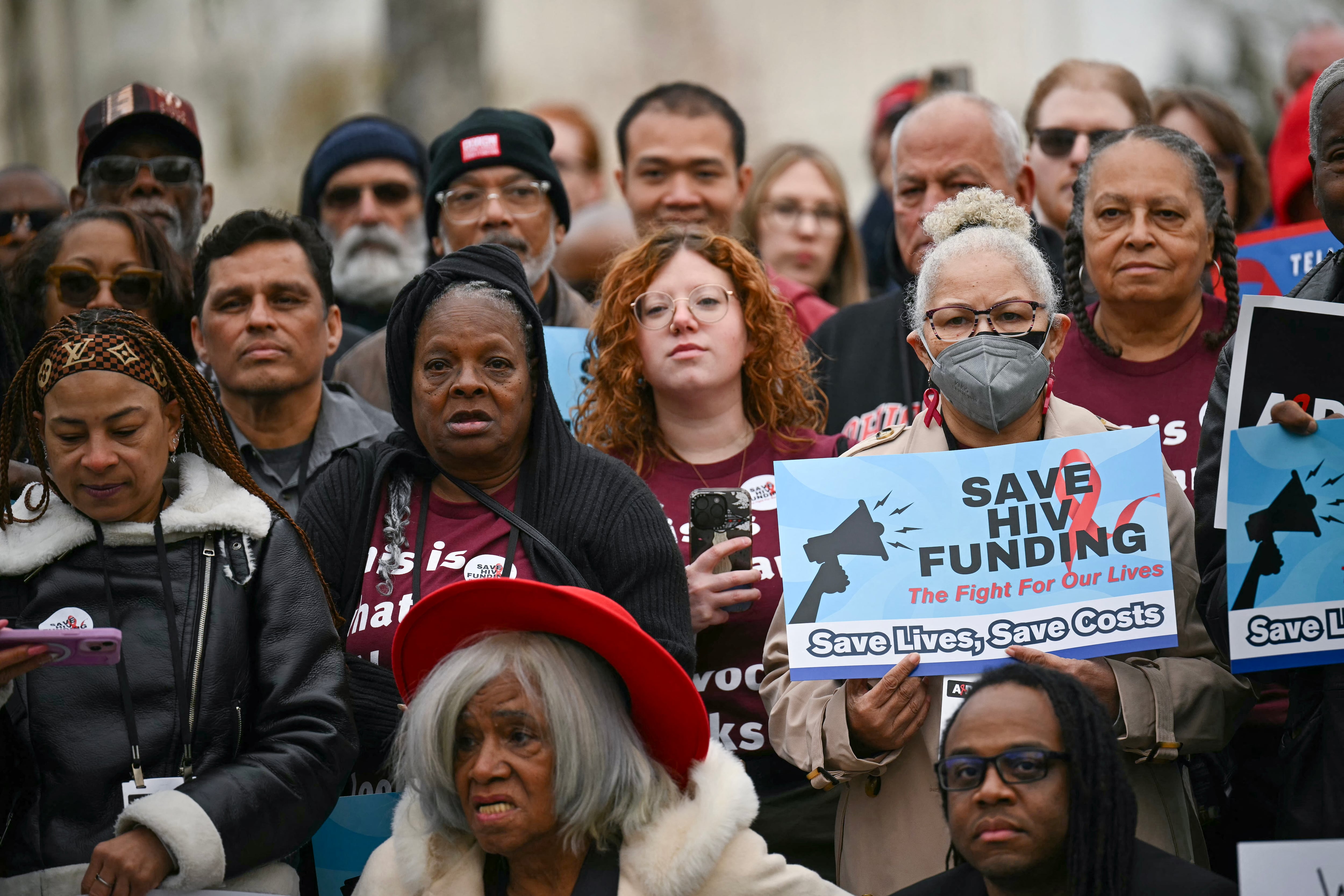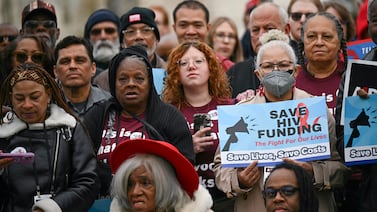This is a guest essay for Healthbeat. Public health, explained: Sign up to receive Healthbeat’s free national newsletter here.
The U.S. government has long been a leader in research and public health practice for preventing HIV infections. Since the start of the Trump administration in 2025, however, extensive cuts have been made or proposed to every federal agency that works on HIV.
These cuts threaten the United States’ goal of ending the HIV epidemic — an initiative launched during the first Trump administration — and will likely lead to substantial increases in HIV infections, HIV-related illness, and health care costs.
HIV prevention has long relied on three primary pillars: behavior, barriers, and biomedicine.
During the first three decades of the epidemic, public health programs focused primarily on the first two pillars. The most important behavioral interventions included delaying the onset of sexual activity, reducing the number of concurrent sexual partners, and avoiding needle sharing. Barrier interventions focused on increasing access to and acceptance of male condoms in health care and social settings.
In 2010, the publication of two landmark clinical trials began shifting the focus of prevention to a biomedical approach. The biomedical approach involves using a combination of HIV antiretroviral therapy medications to either prevent or treat HIV infection.
The iPrEx trial, published in 2010, found that daily use of two ART medications markedly reduced the risk of acquiring HIV among men who have sex with men and transgender women. One year later, the HPTN 052 trial found that early initiation of ART (usually as a combination of three medications) in a person with HIV infection almost completely eliminated the risk of them transmitting HIV to an uninfected partner.
Subsequent studies across diverse populations — including injection drug users, heterosexual couples, and men who have sex with men — confirmed that ART can protect a person without HIV from getting infected and can render a person with HIV non-infectious (“undetectable” viral load means “untransmissible”).
How did biomedical HIV prevention become part of national policy?
HIV experts began advocating for a paradigm shift in clinics and community services toward “status neutral care.” This is the model used in the clinics where I currently treat patients with or at risk of HIV: prevention and care is managed together by the same providers, just as happens with other chronic medical conditions such as diabetes or high blood pressure. All adult and adolescent patients are offered HIV testing, people who test negative are offered PrEP, and people who test positive are treated with ART.
In 2019, the U.S. Preventive Services Task Force gave PrEP a grade “A” recommendation for HIV prevention, requiring health insurers to cover it at no cost as part of the Affordable Care Act. That same year, then-President Donald Trump announced the U.S. national plan to End the HIV Epidemic, which included PrEP for HIV uninfected and ART for HIV infected patients as core parts of its strategy.
What is the current state of the HIV epidemic?
The U.S. government website (HIV.gov) summarizes the latest data on the domestic HIV epidemic. About 1.2 million people in the United States have HIV infection. About 13% of the 1.2 million HIV infected don’t know they are infected. An estimated 31,800 people acquired HIV infection in 2022, which was a 12% decrease from 2018.
Until recently, the U.S. government strategy to reduce HIV infections has focused on expanding access to HIV prevention and care services, particularly in communities disproportionately impacted by HIV: Black and brown people; gay, bisexual, and other men who have sex with men; transgender people; and people living in the South.
The U.S. government has also invested heavily in new biomedical innovation, supporting research into long-acting formulations that can make prevention and treatment even easier. The most promising innovation is lenacapavir, the first of a new class of HIV drugs (capsid inhibitors).
Clinical trials have demonstrated that one injection of lenacapavir every 6 months prevents HIV infection, and a recent small, early stage clinical trial generated substantial excitement for the possibility that it could be used once every 12 months – essentially mimicking an annual vaccine
What cuts have been made to HIV programs at the federal level?
All of this progress, however, is now at risk. A sweeping combination of budget cuts, policy changes, and proposed reorganization of agencies suggests that the federal government is retreating from HIV prevention.
The U.S. Department of Health and Human Services is closing the Office of Infectious Disease and HIV/AIDS Policy (OIDP), which coordinates national strategy and publishes the HIV epidemic dashboard.
At the National Institute for Allergy and Infectious Diseases, key researchers have been removed from their positions, and HIV research grants have been cancelled.
Multiple programs within the Centers for Disease Control and Prevention’s Division of HIV/AIDS Prevention have been cut, along with services for infectious diseases that impact people with HIV, such as sexually transmitted infections and viral hepatitis. The CDC/HRSA Advisory Committee on HIV, Viral Hepatitis, and STD Prevention and Treatment has also been disbanded, cutting off a key channel for expert input and public accountability.
HHS officials have discussed removing HIV entirely from CDC and placing it within the HHS program that provides HIV-related health care to people not covered by other insurance programs.
On top of these announced cuts are proposed reductions in Medicaid included in the congressional budget framework. Medicaid is the largest source of coverage for people with HIV and for low-income Americans at risk of HIV infection. If eligibility is narrowed, benefits are reduced, or states are given more leeway to drop enrollees, many individuals could lose access to PrEP and ART.
Globally, the defunding of the U.S. President’s Emergency Plan for AIDS Relief (PEPFAR) will increase the burden of HIV globally, eventually leading to more HIV infections spilling back into the United States through travel or migration.
What will be the impact of legal and cultural changes on HIV prevention?
Beyond direct funding cuts, legal and cultural shifts present threats to HIV prevention.
A federal lawsuit before the Supreme Court questions whether the Affordable Care Act can mandate insurance coverage for PrEP at no cost to patients. If the court rules that this mandate violates religious freedom or exceeds government authority, it could lead to many insurance companies reducing coverage for PrEP.
The increase in anti-LGBTQ+ rhetoric and legislation across the country, especially targeting transgender people, may deter people from visiting health care facilities and disclosing information about their sexual practices.
Will HIV infections rise, and how much would this cost?
To understand the impact of these changes, consider, for example, the continuum that leads from discovery to delivery of a new HIV medication.
A new medication must be researched and developed in laboratories. It is then tested in humans through large clinical trials across multiple different states over multiple years. If successful, the medication is integrated into expert guidance, promoted through professional and public education, incorporated into insurance coverage, and adopted in real-world care settings. Every stage requires funding, planning, coordination, and education. Eventually, public health agencies need to monitor uptake and address disparities in coverage. Government experts at the National Institutes of Health and CDC have historically been involved at every step in this process.
When every step of this link is weakened, the result is predictable: rising HIV infections. Even small decreases in PrEP use or adherence to ART can have ripple effects, undermining decades of progress and sparking new chains of transmission.
The cost is not just in human welfare. It’s financial as well. A person with HIV infection costs the U.S. health care system up to seven times more in lifetime medical costs than a person without HIV infection: lifetime medical costs of $983,897 compared with $133,340 for uninfected people, an incremental difference of $850,557.
If HIV infections return to the 2018 level — before PrEP became part of national policy — that would mean an additional 4,500 infections or an additional $3.8 billion in lifetime costs for the U.S. health care system.
What can be done to reduce HIV funding cuts?
It is possible that local and state governments can fill some of these gaps with their own funding and programs. Private donors could help defray the loss of federal funding to community-based organizations, which are often the frontline of HIV prevention. And health care systems can continue adopting and refining a status-neutral approach that incorporates HIV into routine medical care without additional funding.
Nevertheless, these efforts are unlikely to sustain and accelerate progress in HIV prevention without a coordinated, well-funded national strategy. We have more effective tools for prevention than ever before. But without the sustained investment and infrastructure to support them, we risk squandering an historic opportunity to end the HIV epidemic.
Dr. Jay K. Varma is a physician and epidemiologist. An expert in the prevention and control of infectious diseases, he has led epidemic responses, developed global and national policies, and implemented large-scale programs that saved hundreds of thousands of lives in Asia, Africa, and the United States.







